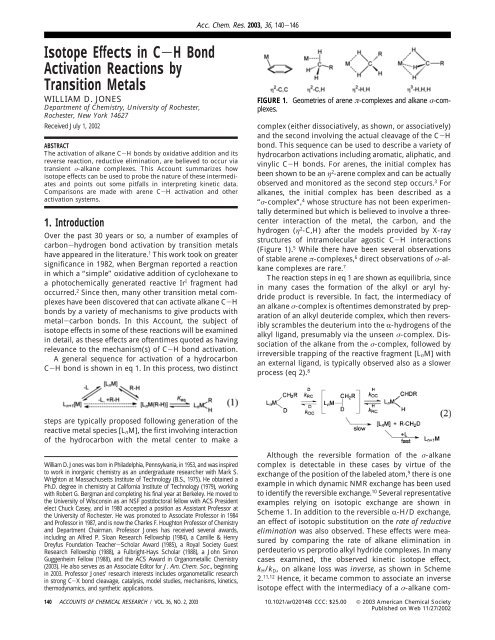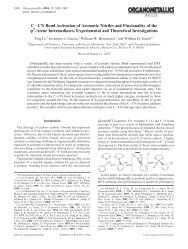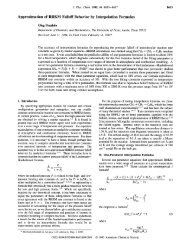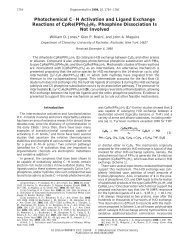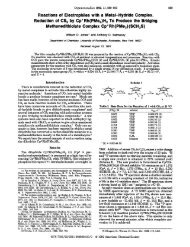Isotope Effects in C-H Bond Activation Reactions by Transition Metals
Isotope Effects in C-H Bond Activation Reactions by Transition Metals
Isotope Effects in C-H Bond Activation Reactions by Transition Metals
Create successful ePaper yourself
Turn your PDF publications into a flip-book with our unique Google optimized e-Paper software.
Acc. Chem. Res. 2003, 36, 140-146<br />
<strong>Isotope</strong> <strong>Effects</strong> <strong>in</strong> C-H <strong>Bond</strong><br />
<strong>Activation</strong> <strong>Reactions</strong> <strong>by</strong><br />
<strong>Transition</strong> <strong>Metals</strong><br />
WILLIAM D. JONES<br />
Department of Chemistry, University of Rochester,<br />
Rochester, New York 14627<br />
Received July 1, 2002<br />
ABSTRACT<br />
The activation of alkane C-H bonds <strong>by</strong> oxidative addition and its<br />
reverse reaction, reductive elim<strong>in</strong>ation, are believed to occur via<br />
transient σ-alkane complexes. This Account summarizes how<br />
isotope effects can be used to probe the nature of these <strong>in</strong>termediates<br />
and po<strong>in</strong>ts out some pitfalls <strong>in</strong> <strong>in</strong>terpret<strong>in</strong>g k<strong>in</strong>etic data.<br />
Comparisons are made with arene C-H activation and other<br />
activation systems.<br />
1. Introduction<br />
Over the past 30 years or so, a number of examples of<br />
carbon-hydrogen bond activation <strong>by</strong> transition metals<br />
have appeared <strong>in</strong> the literature. 1 This work took on greater<br />
significance <strong>in</strong> 1982, when Bergman reported a reaction<br />
<strong>in</strong> which a “simple” oxidative addition of cyclohexane to<br />
a photochemically generated reactive Ir I fragment had<br />
occurred. 2 S<strong>in</strong>ce then, many other transition metal complexes<br />
have been discovered that can activate alkane C-H<br />
bonds <strong>by</strong> a variety of mechanisms to give products with<br />
metal-carbon bonds. In this Account, the subject of<br />
isotope effects <strong>in</strong> some of these reactions will be exam<strong>in</strong>ed<br />
<strong>in</strong> detail, as these effects are oftentimes quoted as hav<strong>in</strong>g<br />
relevance to the mechanism(s) of C-H bond activation.<br />
A general sequence for activation of a hydrocarbon<br />
C-H bond is shown <strong>in</strong> eq 1. In this process, two dist<strong>in</strong>ct<br />
FIGURE 1. Geometries of arene π-complexes and alkane σ-complexes.<br />
complex (either dissociatively, as shown, or associatively)<br />
and the second <strong>in</strong>volv<strong>in</strong>g the actual cleavage of the C-H<br />
bond. This sequence can be used to describe a variety of<br />
hydrocarbon activations <strong>in</strong>clud<strong>in</strong>g aromatic, aliphatic, and<br />
v<strong>in</strong>ylic C-H bonds. For arenes, the <strong>in</strong>itial complex has<br />
been shown to be an η 2 -arene complex and can be actually<br />
observed and monitored as the second step occurs. 3 For<br />
alkanes, the <strong>in</strong>itial complex has been described as a<br />
“σ-complex”, 4 whose structure has not been experimentally<br />
determ<strong>in</strong>ed but which is believed to <strong>in</strong>volve a threecenter<br />
<strong>in</strong>teraction of the metal, the carbon, and the<br />
hydrogen (η 2 -C,H) after the models provided <strong>by</strong> X-ray<br />
structures of <strong>in</strong>tramolecular agostic C-H <strong>in</strong>teractions<br />
(Figure 1). 5 While there have been several observations<br />
of stable arene π-complexes, 6 direct observations of σ-alkane<br />
complexes are rare. 7<br />
The reaction steps <strong>in</strong> eq 1 are shown as equilibria, s<strong>in</strong>ce<br />
<strong>in</strong> many cases the formation of the alkyl or aryl hydride<br />
product is reversible. In fact, the <strong>in</strong>termediacy of<br />
an alkane σ-complex is oftentimes demonstrated <strong>by</strong> preparation<br />
of an alkyl deuteride complex, which then reversibly<br />
scrambles the deuterium <strong>in</strong>to the R-hydrogens of the<br />
alkyl ligand, presumably via the unseen σ-complex. Dissociation<br />
of the alkane from the σ-complex, followed <strong>by</strong><br />
irreversible trapp<strong>in</strong>g of the reactive fragment [L n M] with<br />
an external ligand, is typically observed also as a slower<br />
process (eq 2). 8<br />
steps are typically proposed follow<strong>in</strong>g generation of the<br />
reactive metal species [L n M], the first <strong>in</strong>volv<strong>in</strong>g <strong>in</strong>teraction<br />
of the hydrocarbon with the metal center to make a<br />
William D. Jones was born <strong>in</strong> Philadelphia, Pennsylvania, <strong>in</strong> 1953, and was <strong>in</strong>spired<br />
to work <strong>in</strong> <strong>in</strong>organic chemistry as an undergraduate researcher with Mark S.<br />
Wrighton at Massachusetts Institute of Technology (B.S., 1975). He obta<strong>in</strong>ed a<br />
Ph.D. degree <strong>in</strong> chemistry at California Institute of Technology (1979), work<strong>in</strong>g<br />
with Robert G. Bergman and complet<strong>in</strong>g his f<strong>in</strong>al year at Berkeley. He moved to<br />
the University of Wiscons<strong>in</strong> as an NSF postdoctoral fellow with ACS President<br />
elect Chuck Casey, and <strong>in</strong> 1980 accepted a position as Assistant Professor at<br />
the University of Rochester. He was promoted to Associate Professor <strong>in</strong> 1984<br />
and Professor <strong>in</strong> 1987, and is now the Charles F. Houghton Professor of Chemistry<br />
and Department Chairman. Professor Jones has received several awards,<br />
<strong>in</strong>clud<strong>in</strong>g an Alfred P. Sloan Research Fellowship (1984), a Camille & Henry<br />
Dreyfus Foundation Teacher-Scholar Award (1985), a Royal Society Guest<br />
Research Fellowship (1988), a Fulbright-Hays Scholar (1988), a John Simon<br />
Guggenheim Fellow (1988), and the ACS Award <strong>in</strong> Organometallic Chemistry<br />
(2003). He also serves as an Associate Editor for J. Am. Chem. Soc., beg<strong>in</strong>n<strong>in</strong>g<br />
<strong>in</strong> 2003. Professor Jones’ research <strong>in</strong>terests <strong>in</strong>cludes organometallic research<br />
<strong>in</strong> strong C-X bond cleavage, catalysis, model studies, mechanisms, k<strong>in</strong>etics,<br />
thermodynamics, and synthetic applications.<br />
Although the reversible formation of the σ-alkane<br />
complex is detectable <strong>in</strong> these cases <strong>by</strong> virtue of the<br />
exchange of the position of the labeled atom, 9 there is one<br />
example <strong>in</strong> which dynamic NMR exchange has been used<br />
to identify the reversible exchange. 10 Several representative<br />
examples rely<strong>in</strong>g on isotopic exchange are shown <strong>in</strong><br />
Scheme 1. In addition to the reversible R-H/D exchange,<br />
an effect of isotopic substitution on the rate of reductive<br />
elim<strong>in</strong>ation was also observed. These effects were measured<br />
<strong>by</strong> compar<strong>in</strong>g the rate of alkane elim<strong>in</strong>ation <strong>in</strong><br />
perdeuterio vs perprotio alkyl hydride complexes. In many<br />
cases exam<strong>in</strong>ed, the observed k<strong>in</strong>etic isotope effect,<br />
k H /k D , on alkane loss was <strong>in</strong>verse, as shown <strong>in</strong> Scheme<br />
2. 11,12 Hence, it became common to associate an <strong>in</strong>verse<br />
isotope effect with the <strong>in</strong>termediacy of a σ-alkane com-<br />
140 ACCOUNTS OF CHEMICAL RESEARCH / VOL. 36, NO. 2, 2003 10.1021/ar020148i CCC: $25.00 © 2003 American Chemical Society<br />
Published on Web 11/27/2002
<strong>Isotope</strong> <strong>Effects</strong> <strong>in</strong> C-H <strong>Bond</strong> <strong>Activation</strong><br />
Jones<br />
Scheme 1 Scheme 2<br />
plex. Furthermore, s<strong>in</strong>ce virtually all of this isotope effect<br />
would likely be associated with the C-H/C-D bondmak<strong>in</strong>g/bond-break<strong>in</strong>g<br />
step, rather than the alkane dissociation<br />
step, the overall isotope effect for alkane loss<br />
was attributed to an <strong>in</strong>verse equilibrium isotope effect (i.e.,<br />
H/D<br />
K eq < 1) separat<strong>in</strong>g the alkyl hydride complex from the<br />
σ-alkane complex.<br />
One explanation for the orig<strong>in</strong> of the <strong>in</strong>verse equilibrium<br />
isotope is that the σ-alkane complex conta<strong>in</strong>s an<br />
<strong>in</strong>tact, strong C-H or C-D bond, whereas the alkyl<br />
hydride complex has a weaker M-H or M-D bond.<br />
Consideration of the zero-po<strong>in</strong>t energy differences associated<br />
with the stretch<strong>in</strong>g frequencies for these bonds<br />
leads to the expectation of an <strong>in</strong>verse equilibrium isotope<br />
effect. 13 That is, with metal-hydrogen stretch<strong>in</strong>g<br />
frequencies be<strong>in</strong>g about two-thirds those of aliphatic C-H<br />
bonds, a smaller difference <strong>in</strong> zero-po<strong>in</strong>t energies is<br />
expected <strong>in</strong> the alkyl hydride complex compared to the<br />
σ-alkane complex. There are two possibilities to be<br />
considered for the transition state separat<strong>in</strong>g these two<br />
complexes. In one case, shown <strong>in</strong> Scheme 3a, the zeropo<strong>in</strong>t<br />
energy difference <strong>in</strong> the transition state is assumed<br />
to be <strong>in</strong>termediate between those of the reactant and<br />
product. In the second case, shown <strong>in</strong> Scheme 3b, the<br />
C-H/C-D stretch<strong>in</strong>g frequency is assumed to disappear<br />
as it becomes the reaction coord<strong>in</strong>ate to break the bond.<br />
In the first case (a), one expects an <strong>in</strong>verse k<strong>in</strong>etic isotope<br />
effect for the conversion of the alkyl hydride complex to<br />
the σ-alkane complex (k RCH /k RCD ), but a normal k<strong>in</strong>etic<br />
isotope effect for the reverse reaction (k OCH /k OCD ). In the<br />
second case (b), one expects normal k<strong>in</strong>etic isotope effects<br />
<strong>in</strong> both directions, with the magnitude of the k<strong>in</strong>etic<br />
isotope effect be<strong>in</strong>g larger for the conversion of the<br />
σ-alkane complex <strong>in</strong>to the alkyl hydride complex.<br />
There are a few important po<strong>in</strong>ts to be recognized<br />
immediately. First, both of these situations are consistent<br />
with an <strong>in</strong>verse equilibrium isotope effect separat<strong>in</strong>g the<br />
alkyl hydride complex from the σ-alkane complex, s<strong>in</strong>ce<br />
the transition state does not affect the equilibrium. Second,<br />
the observation of an <strong>in</strong>verse k<strong>in</strong>etic isotope effect<br />
for the loss of alkane from an alkyl hydride/deuteride complex<br />
cannot, <strong>in</strong> itself, dist<strong>in</strong>guish between these two cases.<br />
Third, to determ<strong>in</strong>e which of the two cases perta<strong>in</strong>s to<br />
any given system, one must determ<strong>in</strong>e two of the three<br />
related isotope effects, s<strong>in</strong>ce the equilibrium isotope effect<br />
is really just the ratio of the forward and reverse k<strong>in</strong>etic<br />
isotope effects (eq 3).<br />
K H/D eq ) k H D<br />
RC /k RC<br />
k H D<br />
OC /k OC<br />
With this somewhat lengthy <strong>in</strong>troduction, we are now<br />
ready to describe a system that is the first to establish<br />
which of the two cases described above leads to the<br />
<strong>in</strong>verse equilibrium isotope effect. We then offer commentary<br />
on related systems described <strong>in</strong> the literature.<br />
2. K<strong>in</strong>etic <strong>Isotope</strong> Effect on Reductive<br />
Coupl<strong>in</strong>g<br />
We use the term “reductive coupl<strong>in</strong>g” to describe the<br />
conversion of an alkyl hydride complex <strong>in</strong>to a σ-alkane<br />
(3)<br />
VOL. 36, NO. 2, 2003 / ACCOUNTS OF CHEMICAL RESEARCH 141
<strong>Isotope</strong> <strong>Effects</strong> <strong>in</strong> C-H <strong>Bond</strong> <strong>Activation</strong><br />
Jones<br />
Scheme 3<br />
complex without loss of alkane. We first set out to measure<br />
the isotope effect on reductive coupl<strong>in</strong>g <strong>in</strong> a methyl<br />
hydride complex but found that, just as <strong>in</strong> the earlier<br />
examples of isotopic scrambl<strong>in</strong>g, the experiments described<br />
a comb<strong>in</strong>ation of isotope effects rather than the<br />
isotope effect on a s<strong>in</strong>gle, isolated step. We were fortunate<br />
to succeed <strong>by</strong> identify<strong>in</strong>g a complex <strong>in</strong> which the reductive<br />
coupl<strong>in</strong>g step is irreversible, unlike the case with other<br />
alkyl hydride complexes. The work centers on the reactive<br />
metal fragment [Tp*Rh(CNR)] (Tp* ) tris(3,5-dimethylpyrazolyl)borate,<br />
R ) neopentyl), which we have shown<br />
to activate a variety of alkane and arene C-H bonds via<br />
oxidative addition. 14,15 The alkyl hydrides are stable for a<br />
few hours at room temperature before they undergo<br />
reductive elim<strong>in</strong>ation, allow<strong>in</strong>g convenient study of their<br />
rearrangements. In benzene solvent, alkane loss is immediately<br />
followed <strong>by</strong> benzene activation to give the<br />
thermodynamically stable phenyl hydride complex, Tp*Rh-<br />
(CNR)(phenyl)H.<br />
Treatment of Tp*Rh(CNR)(i-Pr)Cl with [Cp 2 ZrH 2 ] 2 <strong>in</strong><br />
C 6 D 6 leads to a rapid metathesis of chloride and hydride<br />
ligands to generate the secondary alkyl hydride complex,<br />
Tp*Rh(CNR)(i-Pr)H. This complex converts to the n-propyl<br />
isomer over the course of about 30 m<strong>in</strong>, which is concomitant<br />
with the loss of propane to quantitatively give<br />
Tp*Rh(CNR)(C 6 D 5 )D after a few hours. K<strong>in</strong>etic model<strong>in</strong>g<br />
of this sequence could be accomplished only if direct<br />
propane loss from the isopropyl hydride complex was<br />
<strong>in</strong>cluded, as the <strong>in</strong>itial rate of formation of Tp*Rh(CNR)-<br />
(C 6 D 5 )D was faster than the <strong>in</strong>itial rate of formation of<br />
Tp*Rh(CNR)(n-Pr)H. This requirement also makes sense<br />
<strong>in</strong> that the conversion of the isopropyl to the n-propyl<br />
isomer is proposed to occur via a sequence <strong>in</strong>volv<strong>in</strong>g<br />
formation of a σ-propane complex bound at the secondary<br />
CH 2 group, followed <strong>by</strong> migration to a term<strong>in</strong>al methyl<br />
group, followed <strong>by</strong> <strong>in</strong>sertion <strong>in</strong>to the methyl C-H bond;<br />
it is reasonable to propose that propane dissociation could<br />
be competitive with the alkane migration. The model<strong>in</strong>g<br />
provides observed rate constants for the conversion of one<br />
species <strong>in</strong>to the next, as shown <strong>in</strong> Scheme 4.<br />
This same experiment was conducted with [Cp 2 ZrD 2 ] 2 ,<br />
produc<strong>in</strong>g <strong>in</strong>itially Tp*Rh(CNR)(CHMe 2 )D. Over time,<br />
Tp*Rh(CNR)(CH 2 CHDCH 3 )H is seen first, and then<br />
Scheme 4<br />
CH 3 CHDCH 3 and Tp*Rh(CNR)(C 6 D 5 )D are observed. At no<br />
time was Tp*Rh(CNR)(CDMe 2 )H observed, the result of<br />
reversible reductive coupl<strong>in</strong>g and oxidative cleavage at the<br />
secondary C-H (or C-D) bond of CH 3 CHDCH 3 . S<strong>in</strong>ce the<br />
reductive coupl<strong>in</strong>g step from the isopropyl hydride (or<br />
deuteride) is irreversible, the observed rate constants for<br />
disappearance of Tp*Rh(CNR)(CHMe 2 )H (or D), k bc + k bd ,<br />
must represent the fundamental rate for just the reductive<br />
coupl<strong>in</strong>g step itself, k RC . S<strong>in</strong>ce this rate constant could be<br />
determ<strong>in</strong>ed with both the rhodium deuteride and the<br />
rhodium hydride complexes, the ratio k RCH /k RCD could be<br />
obta<strong>in</strong>ed directly. From the rate constants obta<strong>in</strong>ed <strong>in</strong> the<br />
least-squares simulations <strong>in</strong> Scheme 4, a k<strong>in</strong>etic isotope<br />
effect for reductive coupl<strong>in</strong>g of k RCH /k RCD ) 2.1 was<br />
obta<strong>in</strong>ed...a normal k<strong>in</strong>etic isotope effect.<br />
3. K<strong>in</strong>etic <strong>Isotope</strong> Effect on Oxidative <strong>Bond</strong><br />
Cleavage and Equilibrium <strong>Isotope</strong> <strong>Effects</strong><br />
We use the term “oxidative cleavage” to describe the<br />
unimolecular conversion of a σ-alkane complex <strong>in</strong>to an<br />
alkyl hydride complex. An experiment was designed to<br />
probe the k<strong>in</strong>etic isotope effect for the oxidative cleavage<br />
reactions, which is the microscopic reverse of the reductive<br />
coupl<strong>in</strong>g. For this experiment, we would need to<br />
142 ACCOUNTS OF CHEMICAL RESEARCH / VOL. 36, NO. 2, 2003
<strong>Isotope</strong> <strong>Effects</strong> <strong>in</strong> C-H <strong>Bond</strong> <strong>Activation</strong><br />
Jones<br />
Scheme 5<br />
observe the rate at which the σ-alkane complex converts<br />
to the alkyl hydride or deuteride product.<br />
This measurement would prove difficult, however,<br />
because it would require observ<strong>in</strong>g the coord<strong>in</strong>atively<br />
unsaturated <strong>in</strong>termediate [Tp*Rh(CNR)] and monitor<strong>in</strong>g<br />
its rate of disappearance <strong>in</strong> deuterio- or protioalkane.<br />
Instead, we chose to generate the [Tp*Rh(CNR)] fragment<br />
<strong>in</strong> the presence of CH 2 D 2 . Rapid coord<strong>in</strong>ation of the<br />
hydrocarbon would generate the σ-methane complex of<br />
CH 2 D 2 , which conta<strong>in</strong>s equal numbers of C-H and C-D<br />
bonds; we could then monitor the k<strong>in</strong>etic selectivity for<br />
formation of Tp*Rh(CNR)(CHD 2 )H vs Tp*Rh(CNR)(CH 2 D)D.<br />
This was accomplished <strong>by</strong> irradiation of the precursor<br />
complex Tp*Rh(CNR)(RNdCdNPh) <strong>in</strong> the <strong>in</strong>ert solvent<br />
C 6 F 6 under 10 atm CH 2 D 2 at low temperature. 15 The ratio<br />
of the k<strong>in</strong>etically formed products was 4.3:1, and over time<br />
at 10 °C the ratio was seen to adjust to ∼1.7:1 (eq 4). Based<br />
upon the <strong>in</strong>itial ratio, the k<strong>in</strong>etic isotope effect for oxidative<br />
cleavage is therefore k OCH /k OCD ) 4.3...a normal<br />
isotope effect, but larger than that seen <strong>in</strong> the reductive<br />
coupl<strong>in</strong>g. Consequently, <strong>in</strong> this system <strong>in</strong>volv<strong>in</strong>g the<br />
activation of alkanes <strong>by</strong> the [Tp*Rh(CNR)] fragment, it is<br />
clearly determ<strong>in</strong>ed that the situation depicted <strong>in</strong> Scheme<br />
3b applies, and the the <strong>in</strong>verse equilibrium isotope effect<br />
arises as a result of two normal isotope effects of different<br />
magnitudes that oppose each other.<br />
Furthermore, one calculates an equilibrium isotope<br />
effect of 2.1/4.3 ) 0.49 from eq 3. This compares reasonably<br />
well with the observed value of 1/1.7 ) 0.59 from<br />
the equilibration seen <strong>in</strong> eq 4. Also, the reductive coupl<strong>in</strong>g<br />
isotope effect (k RCH /k RCD ) was determ<strong>in</strong>ed for the isopropyl<br />
hydride complex, but it is reasonable to expect a similar<br />
isotope effect with the methyl hydride complex.<br />
In a separate exam<strong>in</strong>ation of the above isotope effects,<br />
the complex Tp*Rh(CNR)(CH 3 )D was synthesized and<br />
allowed to equilibrate with Tp*Rh(CNR)(CH 2 D)H, similar<br />
to other cases that have been reported <strong>in</strong> the literature.<br />
Scheme 5 summarizes the k<strong>in</strong>etics for the complex, and<br />
FIGURE 2. Scrambl<strong>in</strong>g of deuterium <strong>in</strong> Tp*Rh(CNR)(CH 3 )D at 26 °C.<br />
Figure 2 shows the distribution of species. From the figure,<br />
one can see that the methyl deuteride and methyl-d 1<br />
hydride complexes are nearly equilibrated after about half<br />
of the methane has been lost, and that K eq ≈ 6.3. In this<br />
example, the complex Tp*Rh(CNR)(CH 2 D)H would be<br />
favored statistically <strong>by</strong> a factor of 3 over Tp*Rh(CNR)-<br />
(CH 3 )D. In addition, there should be an equilibrium<br />
isotope effect of 2.05 () (k OCH /k OCD )/(k RCH /k RCD ) ) 4.3/2.1).<br />
With the comb<strong>in</strong>ation of these two effects, one expects<br />
an equilibrium ratio of these two complexes of about 6.1:<br />
1. The excellent agreement <strong>in</strong> this <strong>in</strong>dependent experiment<br />
<strong>in</strong>dicates that the assumptions made about the<br />
isotope effects transfer reasonably well from one Tp*Rh-<br />
(CNR)(alkyl)H complex to another.<br />
In addition, it was possible to simulate <strong>in</strong> detail the<br />
microscopic k<strong>in</strong>etics of the Tp*Rh(CNR)(CH 3 )D system,<br />
as described previously <strong>in</strong> detail. 15 The data treatment<br />
allowed the determ<strong>in</strong>ation of relative rate constants <strong>in</strong> this<br />
system, but not absolute rate constants for any reaction<br />
stemm<strong>in</strong>g from the σ-methane complex (s<strong>in</strong>ce no σ-methane<br />
complex is directly observed). The fitted rate constants<br />
provide a value for the oxidative bond formation isotope<br />
effect, k OCH /k OCD , of 4.8, compared with the direct observation<br />
of 4.3 from eq 4. Aga<strong>in</strong>, good agreement is seen.<br />
The fitted rate constants also give a value for K eq of 7.1,<br />
compar<strong>in</strong>g well with the observed value of 6.3 toward the<br />
end of the reaction <strong>in</strong> Figure 2.<br />
4. <strong>Isotope</strong> <strong>Effects</strong> <strong>in</strong> Arene <strong>Activation</strong> <strong>by</strong><br />
[Cp*Rh(PMe 3 )]<br />
Just as H/D scrambl<strong>in</strong>g has been taken as evidence for<br />
the <strong>in</strong>termediacy of σ-alkane complexes, H/D scrambl<strong>in</strong>g<br />
<strong>in</strong> aryl deuteride complexes has been taken as provid<strong>in</strong>g<br />
evidence for η 2 -arene complexes (eq 5). The η 2 -benzene<br />
complex can be seen <strong>in</strong> transient absorption experiments,<br />
and with naphthalene, the equilibrium is such that both<br />
η 2 -arene and aryl hydride complex can be directly ob-<br />
VOL. 36, NO. 2, 2003 / ACCOUNTS OF CHEMICAL RESEARCH 143
<strong>Isotope</strong> <strong>Effects</strong> <strong>in</strong> C-H <strong>Bond</strong> <strong>Activation</strong><br />
Jones<br />
served. 3 In addition, reductive elim<strong>in</strong>ation reactions of aryl<br />
hydride/deuteride complexes can give <strong>in</strong>verse isotope<br />
effects. Do these systems correspond to the picture <strong>in</strong><br />
Scheme 3a or 3b with regard to isotope effects?<br />
One system that has been <strong>in</strong>vestigated <strong>in</strong> detail uses<br />
Cp*Rh(PMe 3 )(Ph)H, <strong>in</strong> which H/D exchange is seen <strong>by</strong><br />
virtue of isotopic exchange between the hydride and the<br />
other positions around the arene r<strong>in</strong>g. 16 This exchange<br />
occurs sequentially, first <strong>in</strong> the ortho, then <strong>in</strong> the meta,<br />
and then <strong>in</strong> the para position, as expected for a mechanism<br />
<strong>in</strong>volv<strong>in</strong>g reversible formation of an η 2 -arene complex<br />
(Scheme 6). At equilibrium, a 2.7:2:2:1 ratio of the<br />
four isomers is observed. S<strong>in</strong>ce there are two ortho and<br />
two meta hydrogens, this corresponds to an equilibrium<br />
isotope effect of K eq ) 1/2.7 ) 0.37 (favor<strong>in</strong>g deuterium<br />
on carbon).<br />
The k<strong>in</strong>etic isotope effect on oxidative cleavage has also<br />
been determ<strong>in</strong>ed. The coord<strong>in</strong>atively unsaturated fragment<br />
[Cp*Rh(PMe 3 )] was created photochemically from<br />
the dihydride <strong>in</strong> the presence of 1,3,5-trideuteriobenzene<br />
at low temperature. Only one η 2 -arene complex is possible,<br />
and the <strong>in</strong>termediate must choose between cleavage of a<br />
C-H orC-D bond (eq 6). The k<strong>in</strong>etic isotope effect on<br />
oxidative cleavage was found to be k OCH /k OCD ) 1.4.<br />
Scheme 6<br />
We now have two isotope effect measurements for the<br />
<strong>in</strong>terconversion of the aryl hydride complex and the η 2 -<br />
arene complex, so the system is determ<strong>in</strong>ed. One can<br />
calculate the k<strong>in</strong>etic isotope effect for reductive coupl<strong>in</strong>g<br />
from (k OCH /k OCD )K eq , and one obta<strong>in</strong>s k RCH /k RCD ) 0.52, an<br />
<strong>in</strong>verse k<strong>in</strong>etic isotope effect. Consequently, this aromatic<br />
system can be described us<strong>in</strong>g Scheme 3a, with an η 2 -<br />
arene complex replac<strong>in</strong>g the σ-alkane complex, and <strong>in</strong><br />
which the transition state for reductive coupl<strong>in</strong>g has an<br />
<strong>in</strong>termediate zero-po<strong>in</strong>t energy associated with it.<br />
5. Comments on Some <strong>Isotope</strong> <strong>Effects</strong> <strong>in</strong> the<br />
Literature<br />
The above analysis can be applied widely to systems <strong>in</strong><br />
which there is an equilibrium followed <strong>by</strong> a ratedeterm<strong>in</strong><strong>in</strong>g<br />
step. Determ<strong>in</strong>ation of two of the three<br />
isotope effects allows determ<strong>in</strong>ation of the third. Likewise,<br />
the system is “undef<strong>in</strong>ed” with regard to Scheme 3 if only<br />
one isotope effect has been measured. In the reported<br />
systems <strong>in</strong>volv<strong>in</strong>g alkane H/D scrambl<strong>in</strong>g, none of them<br />
(except the Tp*Rh(CNR) system) measures more than one<br />
isotope effect (usually for alkane loss), and therefore the<br />
orig<strong>in</strong> of an <strong>in</strong>verse isotope effect rema<strong>in</strong>s undef<strong>in</strong>ed. 17<br />
A recent report <strong>by</strong> Ke<strong>in</strong>an et al. claims to have<br />
determ<strong>in</strong>ed that reductive coupl<strong>in</strong>g <strong>in</strong> a methyl deuteride<br />
complex, TpPtMeD 2 , has an <strong>in</strong>verse k<strong>in</strong>etic isotope effect. 18<br />
Deeper exam<strong>in</strong>ation of the report, however, reveals that<br />
only one of the three isotope effects that determ<strong>in</strong>e the<br />
equilibrium between methyl hydride and σ-methane<br />
complex has been measured (the overall equilibrium<br />
isotope effect). Consequently, their claim that the reductive<br />
coupl<strong>in</strong>g step <strong>in</strong>volves an <strong>in</strong>verse k<strong>in</strong>etic isotope effect<br />
must be rejected as arbitrary, s<strong>in</strong>ce <strong>in</strong>sufficient measurements<br />
were made to support this statement. The k<strong>in</strong>etic<br />
analysis presented erroneously assumed that the scrambl<strong>in</strong>g<br />
reaction was irreversible. Their treatment specifically<br />
neglected the isotope effect on oxidative cleavage (k OCH /<br />
k OCD ) follow<strong>in</strong>g the rate-determ<strong>in</strong><strong>in</strong>g reductive coupl<strong>in</strong>g<br />
step, and consequently is flawed. 19 The observed isotope<br />
effects reported <strong>by</strong> Ke<strong>in</strong>an et al. are not isotope effects<br />
for fundamental steps, but actually reflect a comb<strong>in</strong>ation<br />
of isotope effects on several steps dur<strong>in</strong>g the approach to<br />
equilibrium, which <strong>in</strong>cludes both k RC and k OC terms. It is<br />
not possible to draw a conclusion as to whether the<br />
isotope effect on reductive coupl<strong>in</strong>g is normal or <strong>in</strong>verse<br />
from their data. [Note added <strong>in</strong> proof: Ke<strong>in</strong>en et al. have<br />
published a correction to their earlier paper, which<br />
<strong>in</strong>dicates that the isotope effect for reductive coupl<strong>in</strong>g is<br />
related to the isotope effect for oxidative coupl<strong>in</strong>g: Lo,<br />
H. C.; Haskel, A.; Kapont, M.; Ke<strong>in</strong>an, E. J. Am. Chem. Soc.<br />
2002, 124, 12626 (Addition/Correction).] Bercaw and coworkers<br />
have made similar observations with (tmeda)Pt-<br />
144 ACCOUNTS OF CHEMICAL RESEARCH / VOL. 36, NO. 2, 2003
<strong>Isotope</strong> <strong>Effects</strong> <strong>in</strong> C-H <strong>Bond</strong> <strong>Activation</strong><br />
Jones<br />
(CH 3 ) 2 (D)(CD 3 OD) <strong>in</strong> CD 3 OD solvent, where no claims<br />
about fundamental isotope effects were made. 9f<br />
In another example, Bullock et al. measured an <strong>in</strong>verse<br />
k<strong>in</strong>etic isotope effect for abstraction of hydride ligand from<br />
a CpW(CO) 3 H complex <strong>by</strong> trityl cation. The authors<br />
support a mechanism <strong>in</strong>volv<strong>in</strong>g a direct hydride transfer,<br />
and therefore the <strong>in</strong>verse isotope effect refers to a s<strong>in</strong>gle<br />
reaction step. They did acknowledge, however, that if the<br />
hydride transfer is reversible, then they may be monitor<strong>in</strong>g<br />
an <strong>in</strong>verse equilibrium isotope effect as opposed to a<br />
k<strong>in</strong>etic <strong>in</strong>verse isotope effect. 20 The discussion presented<br />
here would then apply.<br />
F<strong>in</strong>ally, there is one report <strong>in</strong> the literature where an<br />
isotope effect on oxidative cleavage of an alkane has been<br />
directly measured. Moore and Bergman exam<strong>in</strong>ed the<br />
photolysis of Cp*Rh(CO) 2 <strong>in</strong> cyclohexane and cyclohexaned<br />
12 <strong>in</strong> liquid krypton solvent and found that they could<br />
observe <strong>by</strong> IR the conversion of the σ-alkane complex to<br />
the alkyl hydride. The values for k OCH /k OCD were about 10-<br />
15 at 163-193 K. 21 This system is somewhat different from<br />
that described <strong>in</strong> Scheme 3, s<strong>in</strong>ce that alkane is quite labile<br />
and there is a rapid equilibrium between bound krypton<br />
and bound alkane prior to the oxidative cleavage (i.e., the<br />
“right-hand” barrier <strong>in</strong> Scheme 3 would be lower than the<br />
“left-hand” barrier). Similar results were obta<strong>in</strong>ed with<br />
neopentane and neopentane-d 12 . 22<br />
In summary, we have found evidence that the <strong>in</strong>verse<br />
k<strong>in</strong>etic isotope effect for alkane reductive elim<strong>in</strong>ation <strong>in</strong><br />
Tp*Rh(CNR)(alkyl)H compounds is due to an <strong>in</strong>verse<br />
equilibrium isotope effect separat<strong>in</strong>g the alkyl hydride<br />
complex from the σ-alkane complex. This <strong>in</strong>verse equilibrium<br />
isotope effect arises due to two oppos<strong>in</strong>g normal<br />
k<strong>in</strong>etic isotope effects of different magnitudes. The case is<br />
different for arenes <strong>in</strong> Cp*Rh(PMe 3 )(aryl)H compounds,<br />
where the <strong>in</strong>verse equilibrium isotope effect is due to an<br />
<strong>in</strong>verse k<strong>in</strong>etic isotope effect oppos<strong>in</strong>g a small normal<br />
isotope effect. F<strong>in</strong>ally, one is rem<strong>in</strong>ded that statements<br />
regard<strong>in</strong>g isotope effects for a s<strong>in</strong>gle step <strong>in</strong> a more<br />
complex reaction require that more than one isotope<br />
effect measurement be made.<br />
References<br />
(1) For overviews on the subject, see: Jones, W. D.; Kakiuchi, F.;<br />
Murai, S. <strong>Activation</strong> of C-H <strong>Bond</strong>s: Stoichiometric <strong>Reactions</strong> and<br />
Catalytic <strong>Reactions</strong>. In Topics <strong>in</strong> Organometallic Chemistry.<br />
<strong>Activation</strong> of Unreactive <strong>Bond</strong>s and Organic Synthesis; Murai, S.,<br />
Ed.; Spr<strong>in</strong>ger: New York, 1999; Vol. 3, Chapters 2 and 3. Crabtree,<br />
R. H. Aspects of Methane Chemistry. Chem. Rev. 1995, 95, 987-<br />
1007.<br />
(2) Janowicz, A. H.; Bergman, R. G. Carbon-Hydrogen <strong>Activation</strong> <strong>in</strong><br />
Completely Saturated Hydrocarbons: Direct Observation of M +<br />
R-H f M(R)(H). J. Am. Chem. Soc. 1982, 104, 352-354.<br />
(3) Belt, S. T.; Dong, L.; Duckett, S. B.; Jones, W. D.; Partridge, M.<br />
G.; Perutz, R. N. Control of η 2 -Arene Coord<strong>in</strong>ation and Carbon-<br />
Hydrogen <strong>Bond</strong> <strong>Activation</strong> <strong>by</strong> Cyclopentadienyl Complexes of<br />
Rhodium. Chem. Commun. 1991, 266-269. Belt, S. T.; Duckett,<br />
S. B.; Helliwell, M.; Perutz, R. N. <strong>Activation</strong> and η 2 -Co-ord<strong>in</strong>ation<br />
of Arenes: Crystal and Molecular Structure of an (η 2 -Hexafluorobenzene)rhodium<br />
Complex. J. Chem. Soc., Chem. Commun.<br />
1989, 928-930. Re<strong>in</strong>artz, S.; White, P. S.; Brookhart, M.; Templeton,<br />
J. L. Structural Characterization of an Intermediate <strong>in</strong> Arene<br />
C-H <strong>Bond</strong> <strong>Activation</strong> and Measurement of the Barrier to C-H<br />
Oxidative Addition: A Plat<strong>in</strong>um(II) η 2 -Benzene Adduct. J. Am.<br />
Chem. Soc. 2001, 123, 12724-12725.<br />
(4) Hall, C.; Perutz, R. N. <strong>Transition</strong> Metal Alkane Complexes. Chem.<br />
Rev. 1996, 96, 3125-3146.<br />
(5) Brookhart, M.; Green, M. L. H. Carbon- - -Hydrogen-<strong>Transition</strong><br />
Metal <strong>Bond</strong>s. J. Organomet. Chem. 1983, 250, 395-408.<br />
(6) Sweet, J. R.; Graham, W. A. G. A η 2 -Arene Complex of Rhenium:<br />
Synthesis, Characterization, and <strong>Activation</strong> of the Aromatic<br />
Carbon-Hydrogen <strong>Bond</strong>s. Organometallics 1983, 2, 135-140.<br />
Jones, W. D.; Dong, L. Direct Observation of η 2 -Arene Complexes<br />
of [(C 5Me 5)Rh(PMe 3)]. J. Am. Chem. Soc. 1989, 111, 8722-8723.<br />
Harman, W. D.; Taube, H. Reactivity of Pentaamm<strong>in</strong>eosmium(II)<br />
with Benzene. J. Am. Chem. Soc. 1987, 109, 1883-1885. Harman,<br />
W. D.; Sek<strong>in</strong>e, M.; Taube, H. Substituent <strong>Effects</strong> on η 2 -Coord<strong>in</strong>ated<br />
Arene Complexes of Pentaamm<strong>in</strong>eosmium(II). J. Am. Chem. Soc.<br />
1988, 110, 5725-5731. Jones, W. D.; Feher, F. J. Comparative<br />
Reactivities of Hydrocarbon Carbon-Hydrogen <strong>Bond</strong>s with a<br />
<strong>Transition</strong>-Metal Complex. Acc. Chem. Res. 1989, 22, 91-100.<br />
Cordone, R.; Taube, H. Pentaamm<strong>in</strong>eosmium(II) η 2 -2,6-Lutid<strong>in</strong>e:<br />
An Intermediate for Carbon-Hydrogen <strong>Activation</strong>. J. Am. Chem.<br />
Soc. 1987, 109, 8101-8102. Brauer, D. J.; Kruger, C. <strong>Bond</strong><strong>in</strong>g of<br />
Aromatic Hydrocarbons to Nickel(0). Structure of Bis(tricyclohexylphosph<strong>in</strong>e)(1,2-η<br />
2 -anthracene)nickel(0)-toluene. Inorg. Chem.<br />
1977, 16, 884-891. van der Heijden, H.; Orpen, A. G.; Pasman, P.<br />
Photochemistry of Tricarbonyl(η 5 -pentamethylcyclopentadienyl)-<br />
rhenium <strong>in</strong> Benzene Solution; Crystal Structure of bis[dicarbonyl-<br />
(η 5 -pentamethylcyclopentadienyl)](µ-η 2 ,η 2′ -benzene)dirhenium. J.<br />
Chem. Soc., Chem. Commun. 1985, 1576-1578. Neithamer, D.<br />
R.; Parkanyi, L.; Mitchell, J. F.; Wolczanski, P. T. η 2 -(N,C)-Pyrid<strong>in</strong>e<br />
and µ-η 2 (1,2):η 2 (4,5)-benzene Complexes of (silox) 3Ta (silox )<br />
t-Bu 3SiO-). J. Am. Chem. Soc. 1988, 110, 4421-4423. Harman, W.<br />
D.; Taube, H. Synthesis of [Os(NH 3) 5(η 2 -tmb)] 2+ : A Valuable<br />
Precursor for Pentaamm<strong>in</strong>eosmium(II) Chemistry. Inorg. Chem.<br />
1987, 26, 2917-2918. Harman, W. D.; Taube, H. π-Localization <strong>in</strong><br />
Aromatic Ligands: Formation of Mixed-Metal η 2 :η 2 -µ-Arene Complexes<br />
of Ruthenium(II) and Osmium(II) Amm<strong>in</strong>es. J. Am. Chem.<br />
Soc. 1988, 110, 7555-7557. Ch<strong>in</strong>, R. M.; Dong, L.; Duckett, S. B.;<br />
Jones, W. D. Multiple η 2 -Arene Coord<strong>in</strong>ation. Structure and<br />
Isomerism of Naphthalene Complexes of Rhodium Phosph<strong>in</strong>e<br />
[(C 5Me 5)Rh(PMe 3)]. Organometallics 1992, 11, 871-876.<br />
(7) Kiel, W. A.; Ball, R. G.; Graham, W. A. G. Carbonyl-η-Hexamethylbenzene<br />
Complexes of Osmium. Carbon-Hydrogen <strong>Activation</strong><br />
<strong>by</strong> (η-C 6Me 6)Os(CO)(H). J. Organomet. Chem. 1990, 383, 481-<br />
496. Lian, T.; Bromberg, S. E.; Yang, H.; Proulz, G.; Bergman, R.<br />
G.; Harris, C. B. Femtosecond IR Studies of Alkane C-H <strong>Bond</strong><br />
<strong>Activation</strong> <strong>by</strong> Organometallic Compounds: Direct Observation of<br />
Reactive Intermediates <strong>in</strong> Room-Temperature Solutions. J. Am.<br />
Chem. Soc. 1996, 118, 3769-3770. Bromberg, S. E.; Yang, H.;<br />
Asplund, M. C.; Lian, T.; McNamara, B. K.; Kotz, K. T.; Yeston, J.<br />
S.; Wilkens, M.; Frei, H.; Bergman, R. G.; Harris, C. B. The<br />
Mechanism of a C-H <strong>Bond</strong> <strong>Activation</strong> Reaction <strong>in</strong> Room-Temperature<br />
Alkane Solution. Science 1997, 278, 260-263. Sun, X.<br />
Z.; Grills, D. C.; Nikiforov, S. M.; Poliakoff, M.; George, M. W.<br />
Remarkable Stability of (η 5 -C 5H 5)Re(CO) 2L(L) n-heptane, Xe, and<br />
Kr): A Time-Resolved Infrared Spectroscopic Study of (η 5 -C 5H 5)-<br />
Re(CO) 3 <strong>in</strong> Conventional and Supercritical Fluid Solution. J. Am.<br />
Chem. Soc. 1997, 119, 7521-7525.<br />
(8) Reductive elim<strong>in</strong>ation is a term that is used to describe the<br />
cleavage of metal-ligand bonds, the formation of ligand-ligand<br />
bonds, and the dissociation of the coupled product from the metal<br />
center. The metal is formally reduced <strong>by</strong> two electrons <strong>in</strong> the<br />
process. To describe the conversion of the alkyl hydride complex<br />
<strong>in</strong>to the σ-alkane complex without loss of alkane, we will use the<br />
term “reductive coupl<strong>in</strong>g”, with an associated rate constant k RC;<br />
for its microscopic reverse, we will use the term “oxidative<br />
cleavage”, with an associated rate constant k OC, s<strong>in</strong>ce oxidative<br />
addition refers to both coord<strong>in</strong>ation of a substrate and the<br />
cleavage of a bond <strong>in</strong> the substrate.<br />
(9) (a) Buchanan, J. M.; Stryker, J. M.; Bergman, R. G. A K<strong>in</strong>etic and<br />
Thermodynamic Study of the Reversible Thermal Carbon-<br />
Hydrogen <strong>Bond</strong> <strong>Activation</strong>/Reductive Elim<strong>in</strong>ation of Alkanes at<br />
Iridium. J. Am. Chem. Soc. 1986, 108, 1537-1550. (b) Periana, R.<br />
A.; Bergman, R. G. Isomerization of the Hydridoalkylrhodium<br />
Complexes Formed on Oxidative Addition of Rhodium to Alkane<br />
Carbon-Hydrogen <strong>Bond</strong>s. Evidence for the Intermediacy of η 2 -<br />
Alkane Complexes. J. Am. Chem. Soc. 1986, 108, 7332-7346. (c)<br />
Bullock, R. M.; Headford, C. E. L.; Hennessy, K. M.; Kegley, S. E.;<br />
Norton, J. R. Intramolecular Hydrogen Exchange Among the<br />
Coord<strong>in</strong>ated Methane Fragments of Cp 2W(H)CH 3. Evidence for the<br />
Formation of a σ-Complex of Methane Prior to Elim<strong>in</strong>ation. J. Am.<br />
Chem. Soc. 1989, 111, 3897-3908. (d) Park<strong>in</strong>, G.; Bercaw, J. E.<br />
Elim<strong>in</strong>ation Processes for Alkyl, Hydride, and Hydroxy Derivatives<br />
of Permethyltungstenocene. Organometallics 1989, 8, 1172-1179.<br />
(e) Gould, G. L.; He<strong>in</strong>ekey, D. M. Reductive Elim<strong>in</strong>ation of Methane<br />
from a Cationic Rhenium Methyl Hydride. Evidence for an<br />
Intermediate Methane Complex. J. Am. Chem. Soc. 1989, 111,<br />
5502-5504. (f) Stahl, S. S.; Lab<strong>in</strong>ger, J. A.; Bercaw, J. E. J. Am.<br />
Chem. Soc. 1996, 118, 5961-5976. (g) Wang, C.; Ziller, J. W.;<br />
VOL. 36, NO. 2, 2003 / ACCOUNTS OF CHEMICAL RESEARCH 145
<strong>Isotope</strong> <strong>Effects</strong> <strong>in</strong> C-H <strong>Bond</strong> <strong>Activation</strong><br />
Jones<br />
Flood, T. C. J. Am. Chem. Soc. 1995, 117, 1647-1648. (h) Mobley,<br />
T. A.; Schade, C.; Bergman, R. G. J. Am. Chem. Soc. 1995, 117,<br />
7822-7823. (i) Chernega, A.; Cook, J.; Green, M. L. H.; Labella,<br />
L.; Simpson, S. J.; Souter, J.; Stephens, A. H. H. J. Chem. Soc.,<br />
Dalton Trans. 1997, 3225-3243.<br />
(10) Gross, C. L.; Girolami, G. S. Metal-Alkane Complexes. Rapid<br />
Exchange of Hydrogen Atoms between Hydride and Methyl<br />
Ligands <strong>in</strong> [(C 5Me 5)Os(dmpm)(CH 3)H + ]. J. Am. Chem. Soc. 1998,<br />
120, 6605-6606.<br />
(11) Examples of <strong>in</strong>verse k H/k D: (a) Cp*Ir(PMe 3)(H)(C 6H 11) <strong>in</strong>C 6D 6 at<br />
130 °C, 0.7(1) (ref 9a). (b) Cp*Rh(PMe 3)(H)(C 2H 5) <strong>in</strong> toluene-d 8 at<br />
-30 °C, 0.5(1) (ref 9b). (c) Cp 2WH(CH 3)<strong>in</strong>CD 3CN at 72.6 °C, 0.75-<br />
(4) (ref 9c). (d) Cp* 2WH(CH 3)<strong>in</strong>C 6D 6 at 100 °C, 0.77(7) (ref 9d). (e)<br />
[Cp 2Re(H)(CH 3)][Cl] <strong>in</strong> CD 2Cl 2 at 9 °C, 0.8(1) (ref 8e). (f) [CnRh-<br />
(PMe 3)(H)(CH 3)][BAr 4]<strong>in</strong>C 6D 6 at 75 °C, 0.74(2) (ref 9 g). (g) (tmeda)-<br />
Pt(CH 3)(H)(Cl) <strong>in</strong> CH 3OH at -27 °C, 0.29 (ref 9f).<br />
(12) Examples of normal k H/k D: (a) Abis, L.; Sen, A.; Halpern, J.<br />
Intramolecular Reductive Elim<strong>in</strong>ation of Alkanes from cis-Hydridoalkylbis(phosph<strong>in</strong>e)plat<strong>in</strong>um(II)<br />
Complexes. J. Am. Chem. Soc.<br />
1978, 100, 2915-2916, (PPh 3) 2Pt(Me)H, 3.3. (b) Michel<strong>in</strong>, R. A.;<br />
Faglia, S.; Uguagliati, P. Mechanism of Reductive Elim<strong>in</strong>ation of<br />
1,1,1-Trifluoroethane from cis-Hydrido(2,2,2-trifluoroethyl)bis-<br />
(triphenylphosph<strong>in</strong>e)-plat<strong>in</strong>um(II). Inorg. Chem. 1983, 22, 1831-<br />
1834, (PPh 3) 2Pt(CH 2CF 3)H, 2.2. (c) Hackett, M.; Ibers, J. A.; Whitesides,<br />
G. M. <strong>Activation</strong> of the Carbon-Hydrogen <strong>Bond</strong>s of Benzene<br />
<strong>by</strong> Reaction with [Bis(Dicyclohexylphosph<strong>in</strong>o)Ethane]Plat<strong>in</strong>um(0),<br />
Generated <strong>by</strong> the Thermolysis of cis-[Bis(dicyclohexylphosph<strong>in</strong>o)ethane]hydridoneopentylplat<strong>in</strong>um(II).<br />
J. Am. Chem.<br />
Soc. 1988, 110, 1436-1448, (Cy 2PCH 2CH 2PCy 2)Pt(CH 2CMe 3)H, 1.5.<br />
(13) Melander, L. C. S.; Saunders, W. Reaction Rates of Isotopic<br />
Molecules; Wiley: New York, 1980.<br />
(14) Hessell, E. T.; Jones, W. D. Synthesis and Structure of Rhodium<br />
Complexes Conta<strong>in</strong><strong>in</strong>g a Photolabile η 2 -Carbodiimide Ligand. 1,3-<br />
Dipolar Cycloaddition of Phenyl azide to Tp′Rh(CNR) 2 [Tp′ )<br />
hydrotris(3,5-dimethylpyrazolyl)borate]. Organometallics 1992, 11,<br />
1496-1505. Jones, W. D.; Hessell, E. T. Mechanism of Benzene<br />
Loss from Tp′Rh(H)(Ph)(CN-neopentyl) <strong>in</strong> the Presence of Neopentyl<br />
Isocyanide. Evidence for an Associatively Induced Reductive<br />
Elim<strong>in</strong>ation. J. Am. Chem. Soc. 1992, 114, 6087-6095. Jones,<br />
W. D.; Hessell, E. T. Photolysis of Tp′Rh(CN-neopentyl)(η 2 -PhN:<br />
C:N-neopentyl) <strong>in</strong> Alkanes and Arenes: K<strong>in</strong>etic and Thermodynamic<br />
Selectivity of [Tp′Rh(CN-Neopentyl)] for Various Types of<br />
Carbon-Hydrogen <strong>Bond</strong>s. J. Am. Chem. Soc. 1993, 115, 554-<br />
562. Wick, D. D.; Jones, W. D. Synthesis and Characterization of<br />
(Tris(3,5-dimethylpyrazolyl)borato)rhodium Alkyl and V<strong>in</strong>yl Chloride<br />
Complexes. Inorg. Chem. 1997, 36, 2723-2729. Wick, D. D.;<br />
Northcutt, T. O.; Lachicotte, R. J.; Jones, W. D. Carbon-Hydrogen<br />
and Carbon-Carbon <strong>Bond</strong> <strong>Activation</strong> of Cyclopropane <strong>by</strong> a<br />
Hydridotris(pyrazolyl)borate Rhodium Complex. Organometallics<br />
1998, 17, 4484-4492. Jones, W. D.; Wick, D. D. Energetics of<br />
Homogeneous Intermolecular V<strong>in</strong>yl and Allyl Carbon-Hydrogen<br />
<strong>Bond</strong> <strong>Activation</strong> <strong>by</strong> the 16-Electron Coord<strong>in</strong>atively Unsaturated<br />
Organometallic Fragment [Tp′Rh(CNCH 2CMe 3)]. Organometallics<br />
1999, 18, 495-505. Wick, D. D.; Reynolds, K. A.; Jones, W. D.<br />
Evidence for Methane σ-Complexes <strong>in</strong> Reductive Elim<strong>in</strong>ation<br />
<strong>Reactions</strong> from Tp′Rh(L)(CH 3)H. J. Am. Chem. Soc. 1999, 121,<br />
3974-3983.<br />
(15) Northcutt, T. O.; Wick, D. D.; Vetter, A. J.; Jones, W. D. Investigation<br />
of the Mechanism of Alkane Reductive Elim<strong>in</strong>ation and<br />
Skeletal Isomerization <strong>in</strong> Tp′Rh(CNneopentyl)(R)H Complexes:<br />
The Role of Alkane Complexes. J. Am. Chem. Soc. 2001, 123,<br />
7257-7270.<br />
(16) Jones, W. D.; Feher, F. J. <strong>Isotope</strong> <strong>Effects</strong> <strong>in</strong> Arene Carbon-<br />
Hydrogen <strong>Bond</strong> <strong>Activation</strong> <strong>by</strong> [(C 5Me 5)Rh(PMe 3)]. J. Am. Chem.<br />
Soc. 1986, 108, 4814-4819.<br />
(17) Park<strong>in</strong> et al. have also been able to determ<strong>in</strong>e the isotope effects<br />
on both oxidative cleavage and reductive coupl<strong>in</strong>g <strong>in</strong> an ansatungstenocene<br />
and an ansa-molybdenocene complex us<strong>in</strong>g<br />
simulations similar to those used for Tp*Rh (CNR). Churchill, D.<br />
G.; Janak, K. E.; Wittenberg, J. S.; Park<strong>in</strong>, G. Normal and Inverse<br />
Primary K<strong>in</strong>etic Deuterium <strong>Isotope</strong> <strong>Effects</strong> for C-H <strong>Bond</strong> Reductive<br />
Elim<strong>in</strong>ation and Oxidative Addition <strong>Reactions</strong> of Molybdenocene<br />
and Tungstenocene Complexes: Evidence for Benzene σ-Complex<br />
Intermediates. J. Am. Chem. Soc., <strong>in</strong> press.<br />
(18) Lo, H. C.; Haskel, A.; Kapon, M.; Ke<strong>in</strong>an, E. TpPt(IV)Me(H) 2 Forms<br />
a σ-CH 4 Complex That Is K<strong>in</strong>etically Resistant to Methane Liberation.<br />
J. Am. Chem. Soc. 2002, 124, 3226-3228. Iron, M. A.; Lo, H.<br />
C.; Mart<strong>in</strong>, J. M. L.; Ke<strong>in</strong>an, E. TpPtMe(H) 2: Why Is There H/D<br />
Scrambl<strong>in</strong>g of the Methyl Group but Not Methane Loss? J. Am.<br />
Chem. Soc. 2002, 124, 7041-7054.<br />
(19) This system was claimed to be unique <strong>in</strong> that methane loss did<br />
not occur, but earlier studies <strong>by</strong> Green 9i with a [Me 2C(C 5H 4) 2]W-<br />
(CH 3)D complex similarly showed no evidence of methane loss,<br />
and also showed similar k<strong>in</strong>etic behavior, yet no claim was made<br />
regard<strong>in</strong>g the isotope effect on reductive coupl<strong>in</strong>g.<br />
(20) Cheng, T.-Y.; Bullock, R. M. <strong>Isotope</strong> <strong>Effects</strong> on Hydride Transfer<br />
<strong>Reactions</strong> from <strong>Transition</strong> Metal Hydrides to Trityl Cation. An<br />
Inverse <strong>Isotope</strong> Effect for a Hydride Transfer. J. Am. Chem. Soc.<br />
1999, 121, 3150-3155.<br />
(21) Schultz, R. H.; Bengali, A. A.; Tauber, M. J.; Weiller, B. H.;<br />
Wasserman, E. P.; Kyle, K. R.; Moore, C. B.; Bergman, R. G. IR<br />
Flash K<strong>in</strong>etic Spectroscopy of C-H <strong>Bond</strong> <strong>Activation</strong> of Cyclohexane-d<br />
0 and -d 12 <strong>by</strong> Cp*Rh(CO) 2 <strong>in</strong> Liquid Rare Gases: K<strong>in</strong>etics,<br />
Thermodynamics, and Unusual <strong>Isotope</strong> Effect. J. Am. Chem. Soc.<br />
1994, 116, 7369-7377.<br />
(22) Bengali, A. A.; Schultz, R. H.; Moore, C. B.; Bergman, R. G.<br />
<strong>Activation</strong> of the C-H <strong>Bond</strong>s <strong>in</strong> Neopentane and Neopentaned<br />
12 <strong>by</strong> (η 5 -C 5(CH 3) 5)Rh(CO) 2: Spectroscopic and Temporal Resolution<br />
of Rhodium-Krypton and Rhodium-Alkane Complex Intermediates.<br />
J. Am. Chem. Soc. 1994, 116, 9585-9589.<br />
AR020148I<br />
146 ACCOUNTS OF CHEMICAL RESEARCH / VOL. 36, NO. 2, 2003


